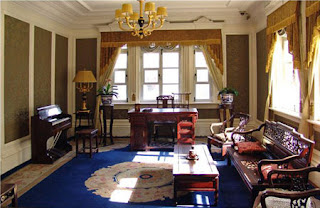The Changbai Mountain
is a mountain range on the border between China
and North Korea.
In Russia this range is
called "Vostochno-Manchzhurskie gory" ("East Manchurian mountain
range") and considered as a part of more long Manchu-Korean mountain
range, which separates China
from Korea
and Russian Primorsky Krai. The range extends from the Northeast Chinese
provinces of Heilongjiang, Jilin
and Liaoning
to the North Korean provinces of Ryanggang and Chagang. Most peaks exceed 2,000
metres in height, with the highest mountain being Changbai Mountain.

The most beautiful
part of Changbai Mountain
is undoubtedly Tianchi, or Heavenly
Lake. The lake was formed
in the crater of the mountain, and it is the source of the Songhua, Tumen and Yalu Rivers.
The altitude of the Heavenly
Lake is 2,189 meters
(about 7,182 ft), and so the
average temperature is 7.3C (45.14 F). With clouds everywhere, Heavenly Lake is like a jade in the sky. You can
find a very interesting phenomenon while walking along the Heavenly Lake.
On many occasions it is common for sunshine and rain to occur at the same time.
It may rain very hard one minute, but you may soon find the sun shining warmly
the next minute. Sometimes, you can even watch it rain in the west and shine in
the east. Besides the wonderful scenery and astonishing climate, many witnesses
have claimed that there are monsters in the lake! Some witnesses even took
photos as proof, but there is still no conclusive evidence.

To the north of Heavenly Lake
there exists an exit for the Chengcha
River. Running gently for
about 1,200 meters (0.74 miles), the river suddenly becomes a churning rapids
and drops from a 68 meters (223
ft) high cliff. This is the famous Changbai Waterfall, the
highest volcanic waterfall in the world. Watching it from far away, the
waterfall appears like a white ribbon suspended in midair. As you approach it,
you can hear the loud roar and feel the chilliness of the waterfall. Another
alternative to watch the waterfall is climbing to Heifengkou on the main peak.
Gales blow ceaselessly in this col, making it hard for visitors to walk and
climb. But it remains the best place to watch the panorama of the waterfall.
Apart from Changbai Waterfall, more than ten smaller waterfalls are also
available in the mountain. Visitors have to enter the Northern Slope Entrance
to see the waterfall.

Less than 2
kilometers (1.24 miles) away from Changbai Waterfall lie the Changbai Hot
Springs. With a special chemical composition inside, the rocks around the hot springs have been
dyed many bright colors. Most of the hot
springs have temperatures over 60 C (140 F);
the highest is 82 C (179.6 F). Hot Spring Eggs have become a
special local product. Visitors can bathe in the hot springs, which are very effective for
some ailments, such as arthritis, dermatosis and exhaustion. ( Tips on Hot
Spring for your reference)

Underground Forest, the attraction with lowest altitude on
the mountain, is famous for its view of virgin forests. Ancient tall trees,
huge rocks, special animals and cliffy canyons have lured many scientists,
explorers and photographers in recent years. Twin
Lakes and Natural Museum
along the Northern Slope are also worth visiting. Additionally, the newly
exploited Great Valley,
Jinjiang Waterfall, King's Lake, Tiger's Back and Tizi River
in the Western Slope also attract many visitors. If visitors want to closely
observe the borders of the PRC and the DPRK and enjoy the beautiful alpine
flowers, they can climb the mountain through the Southern Slope Entrance.
During the peak
seasons, namely June through September, hundreds of flowers blossom on the
Southern and Western slopes. It is very cool, so it's an ideal place for
escaping from the summer heat. But it is also very rainy in July and August,
and visitors cannot watch the Heavenly
Lake clearly at that
time. The best time to visit the mountain is September. Generally, it snows
from October. The best time to view snow and to ski is from November to March.
Ice and snow begin to thaw from April, but visitors can still find snow even in
May.
Visitors can stay
with Korean families to understand the local life, or they can camp in the
forest to breathe the fresh air of woods and flowers. There are also
top-ranking hotels, such as Heavenly Hot Spring Hotel, Changbai Mountain
International Hotel, and Athletes' Village. Changbai Mountain
is also a rich area for wild fungus and traditional Chinese medicine materials,
such as ginseng and pilose antler. Visitors can find them in local shops.









































